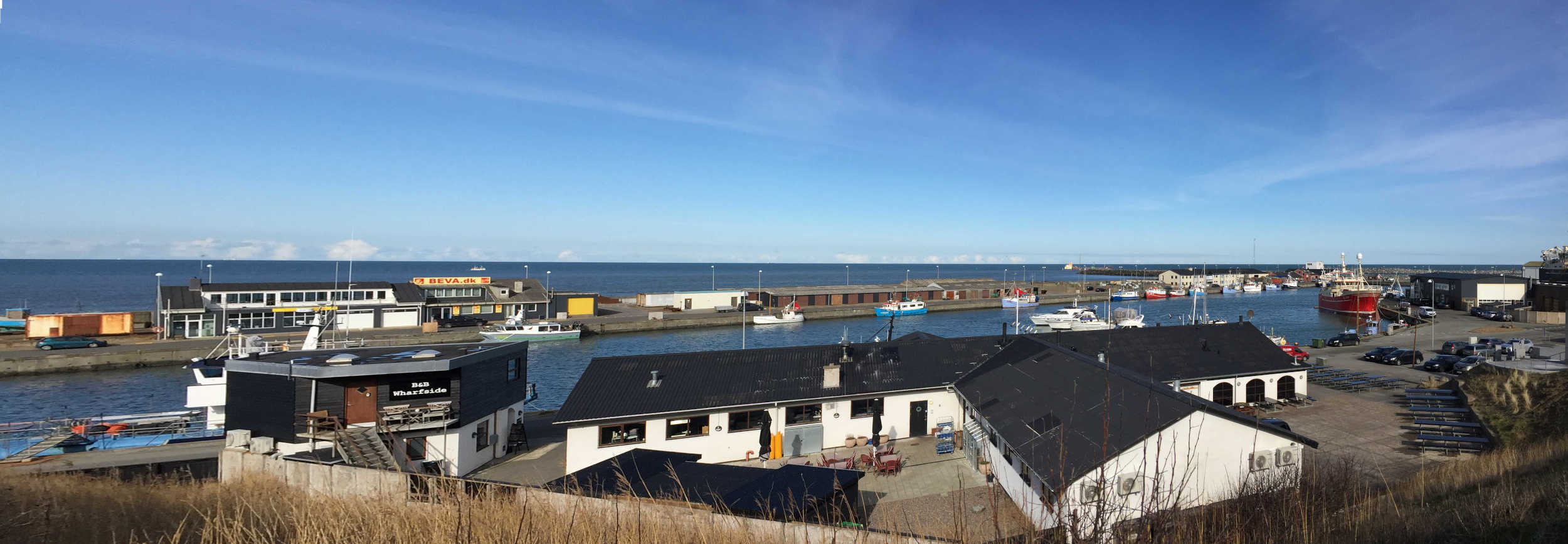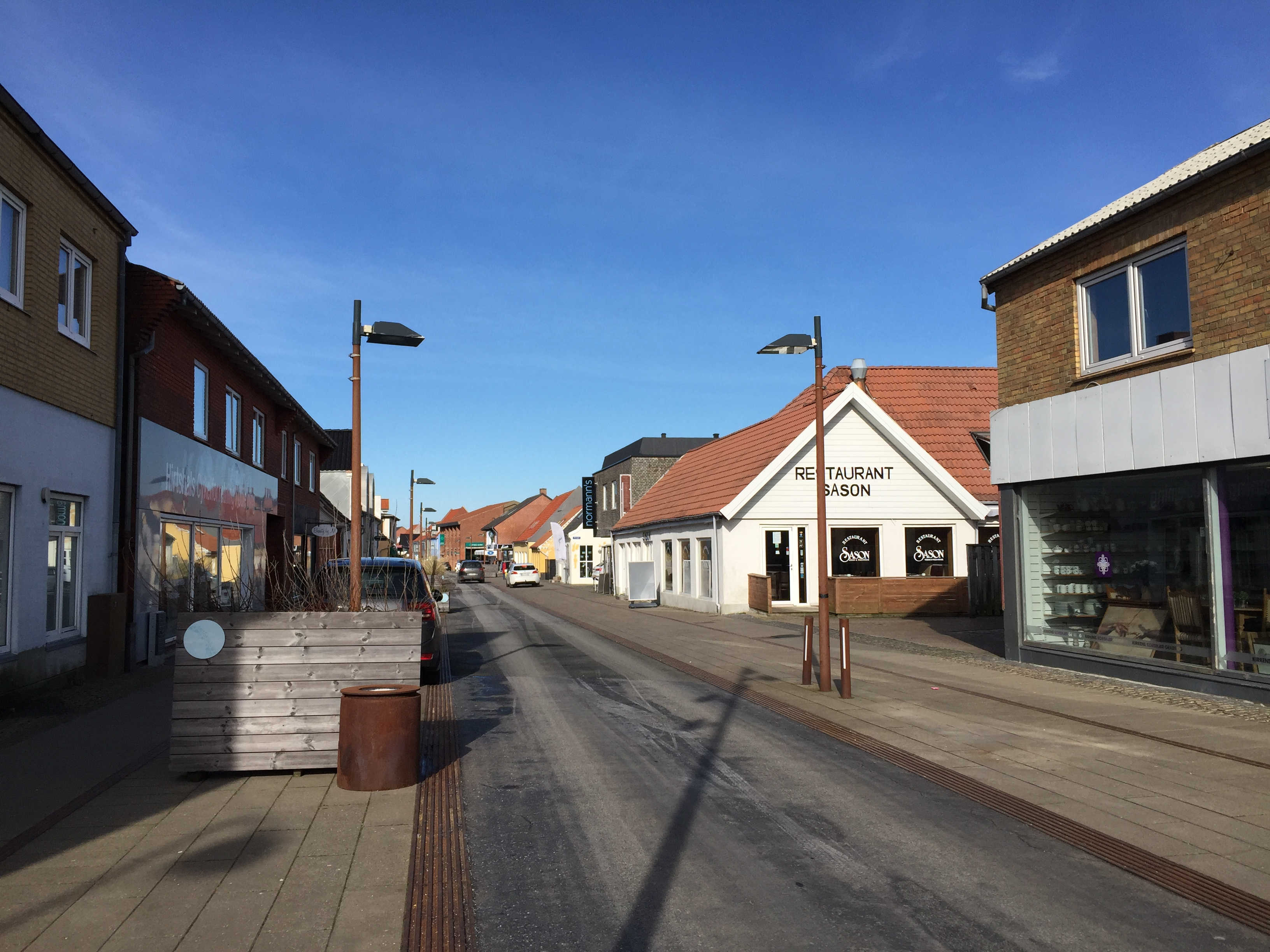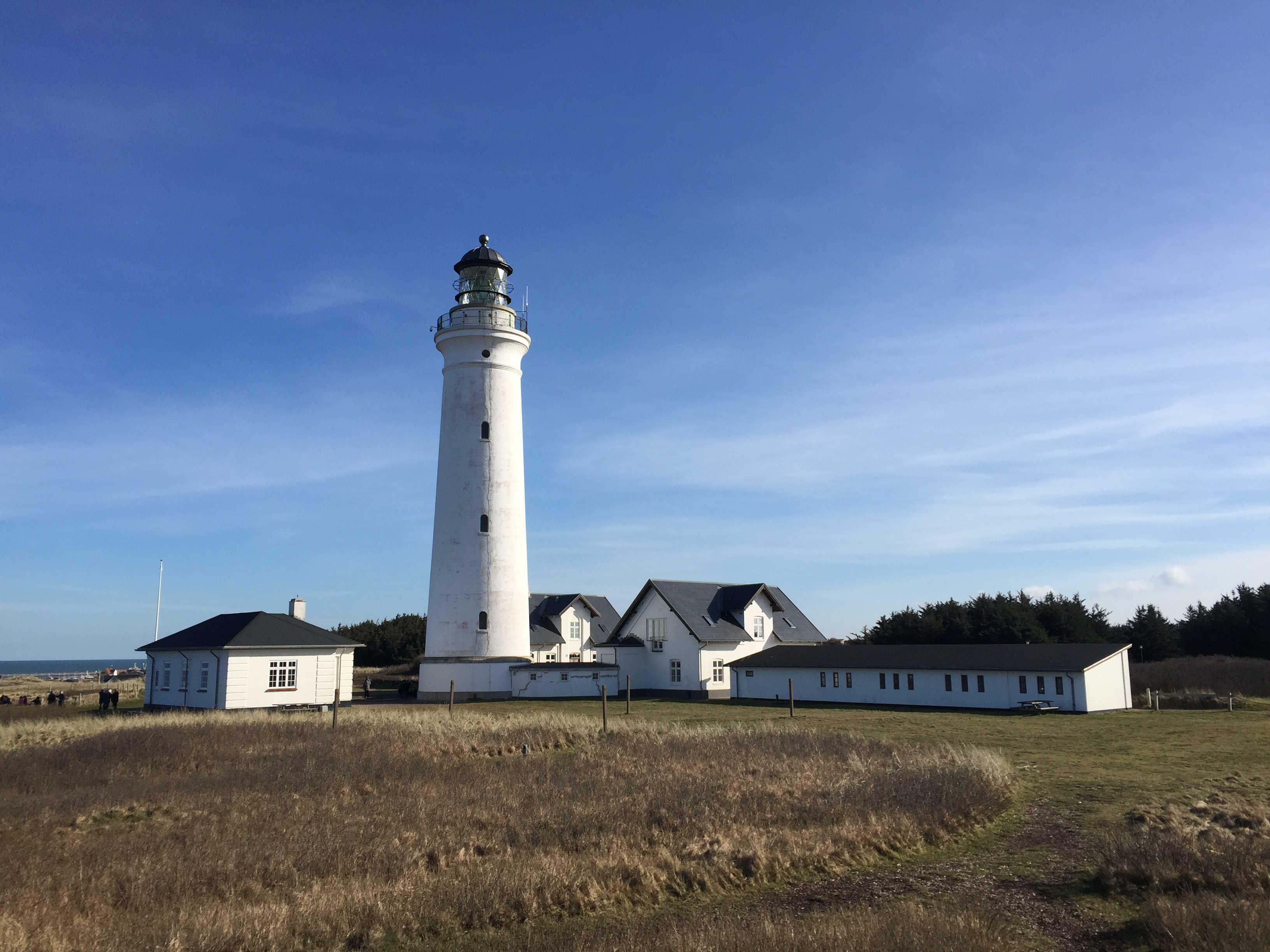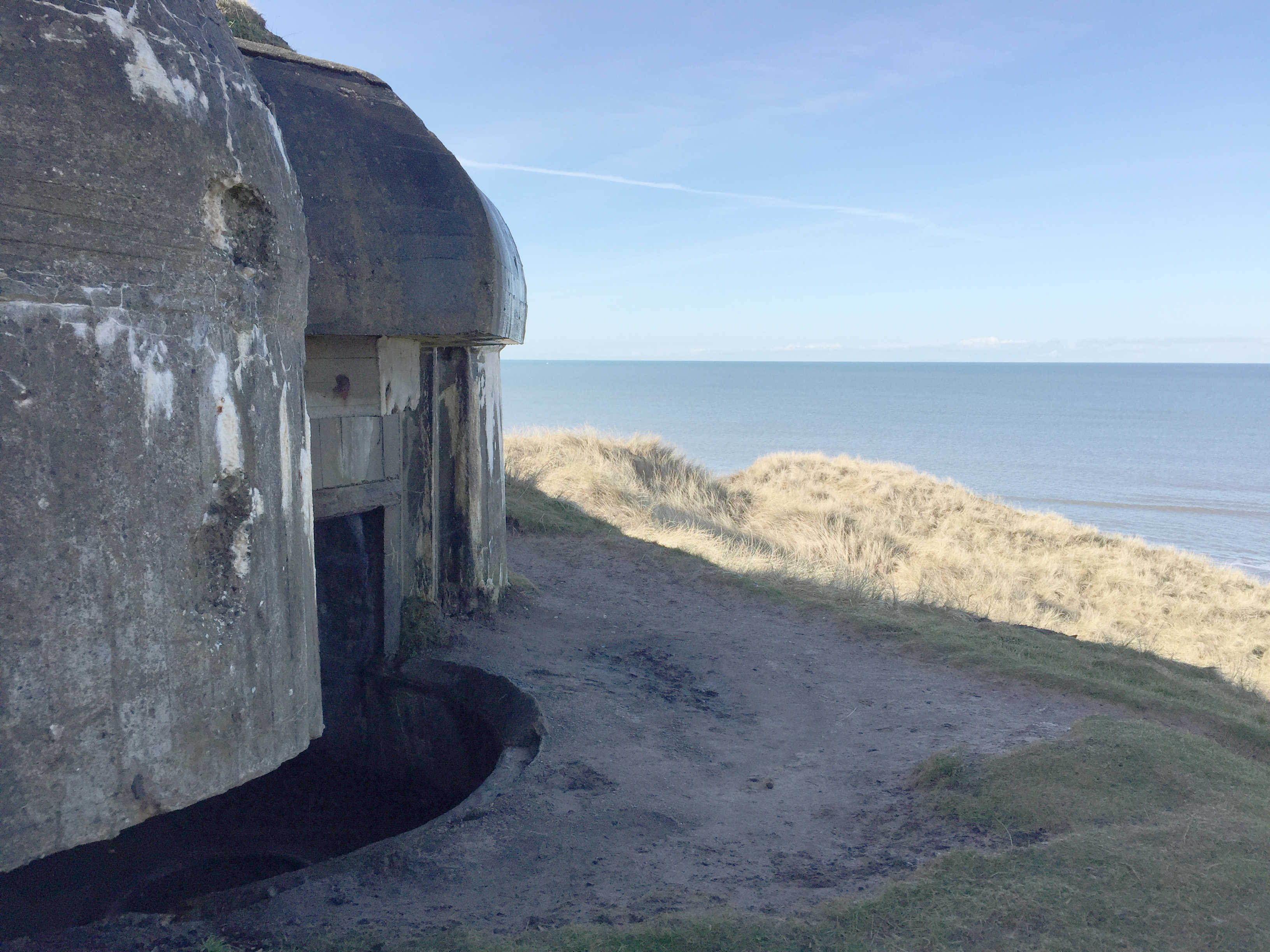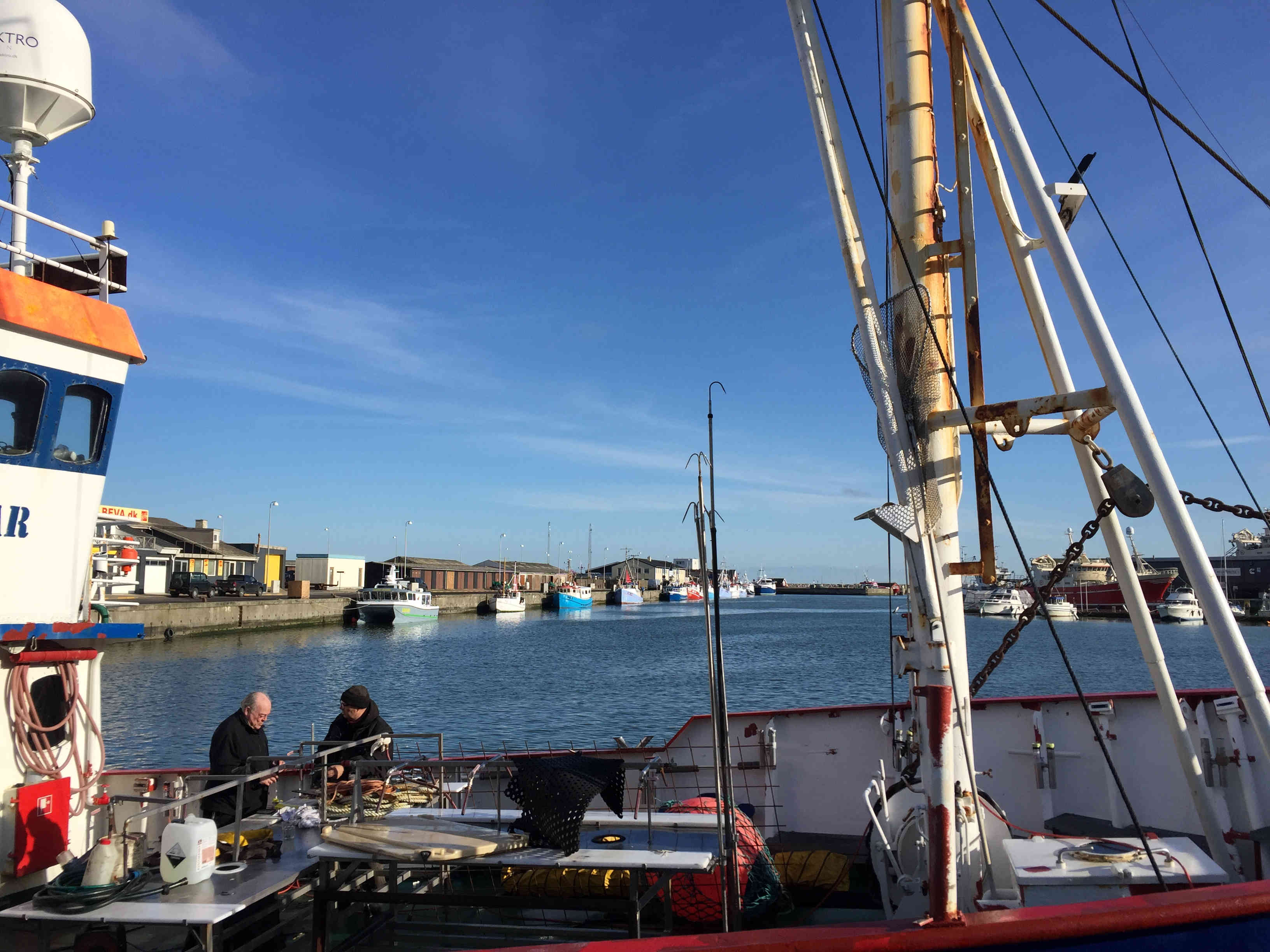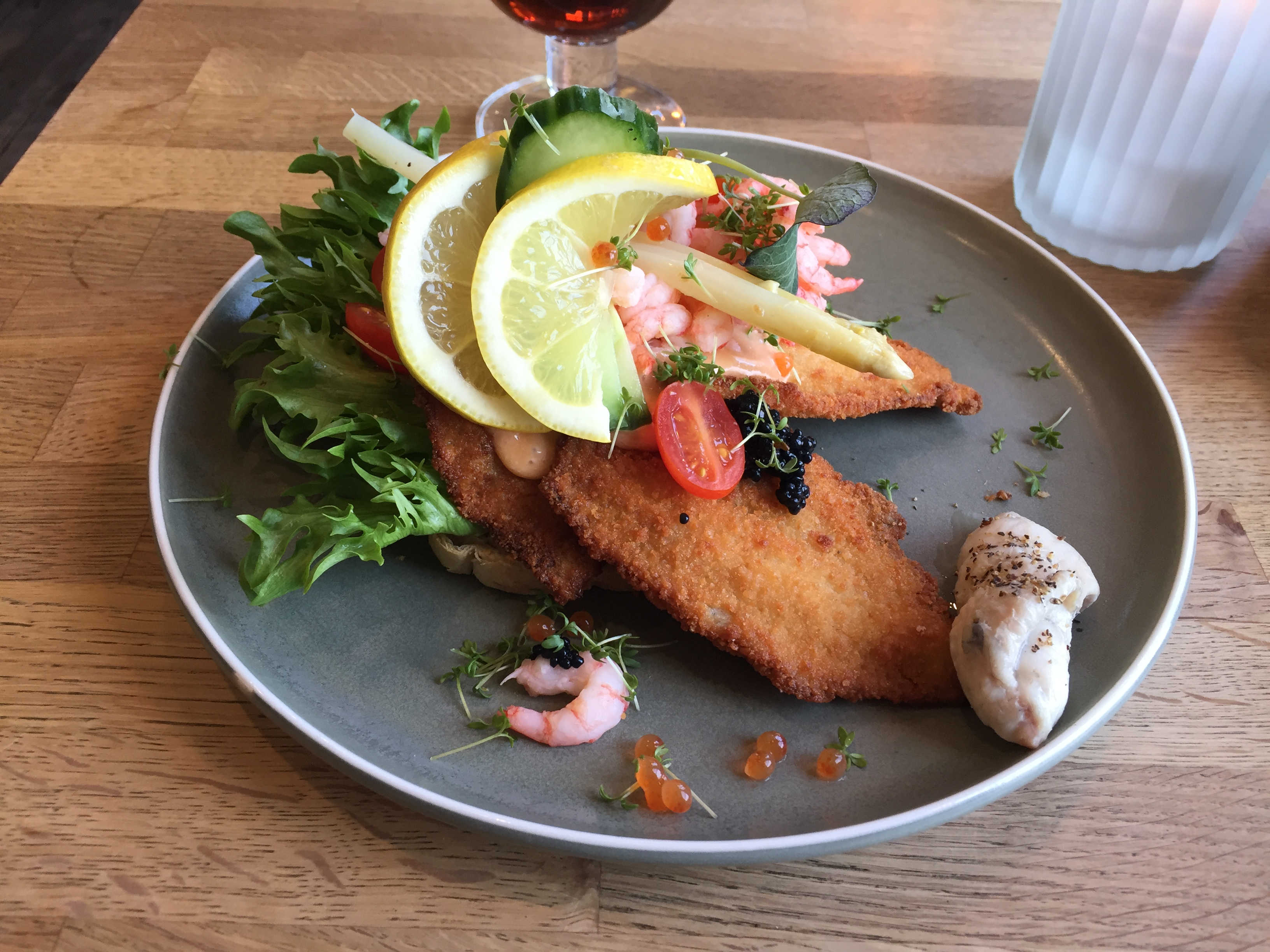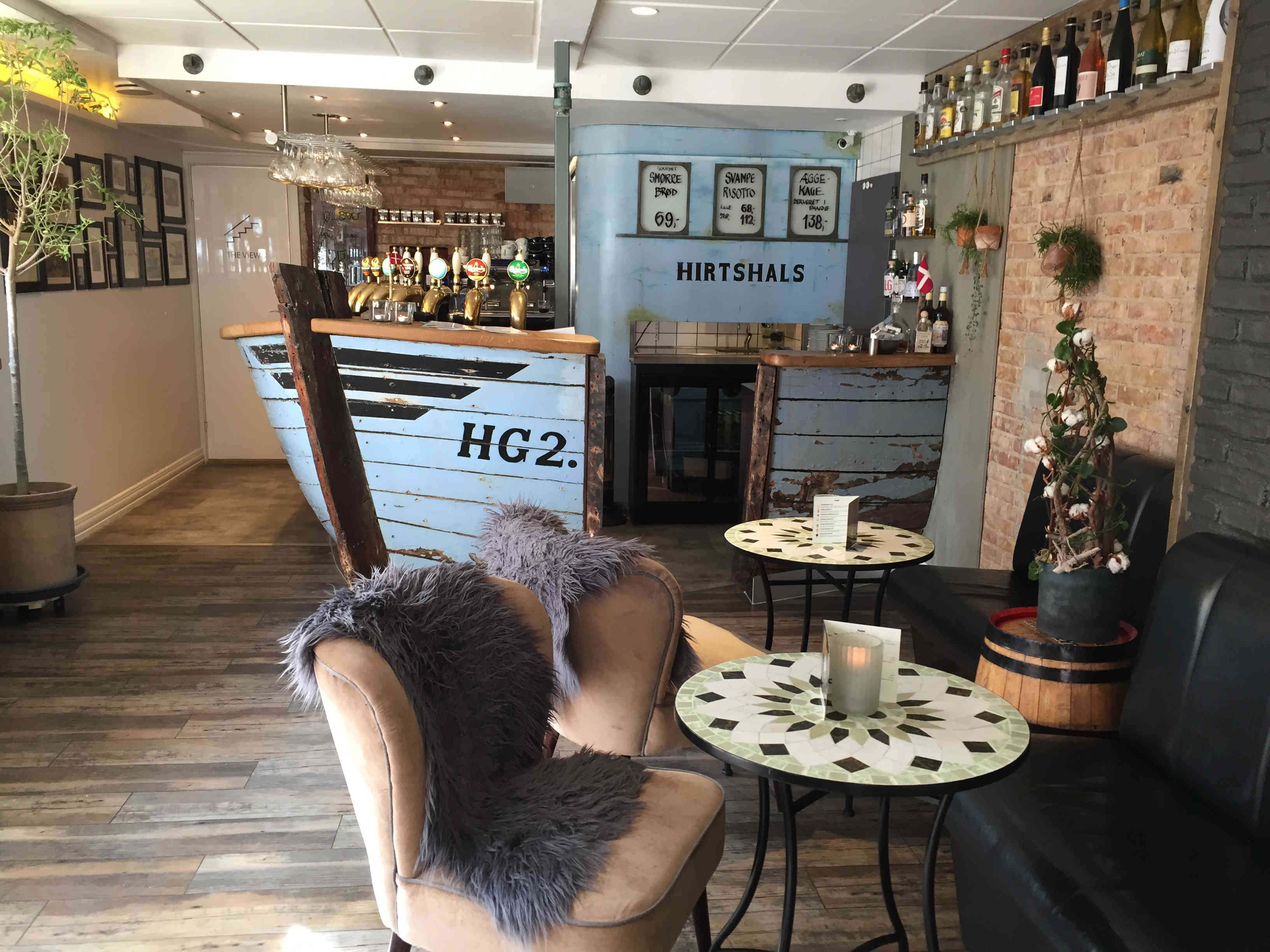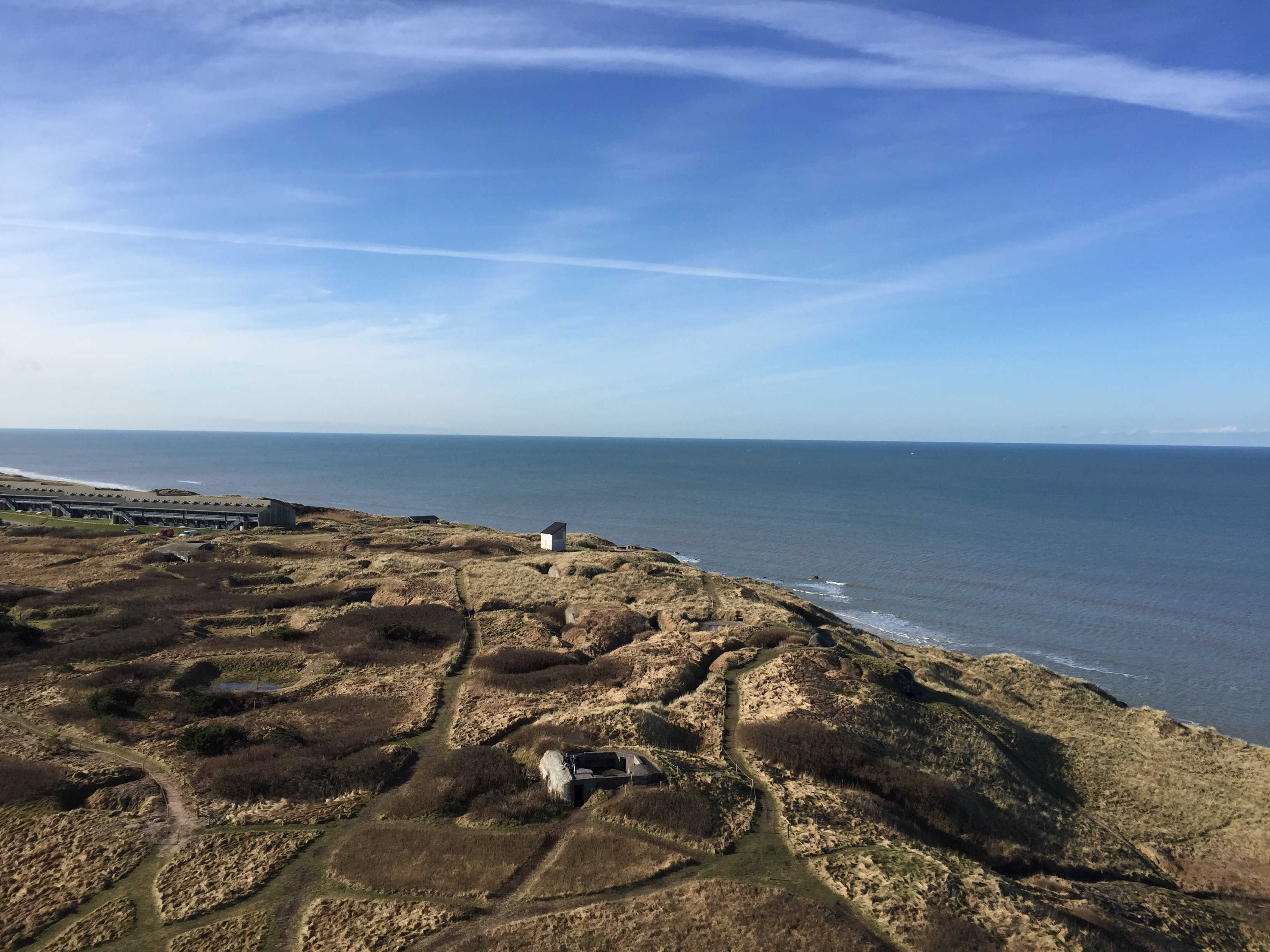Port cities with exclusive, symbiotic and intense karmic bond with its own harbour can be counted on the fingers one hand … and Hirtshals is one of these.
The brand-new city – born in 1919 – was founded on the occasion of the launch of a new artificial harbor located in the extreme north of Denmark, (previous image), strategic centre of gravity of maritime trades between Scandinavian countries. In the first decades of the Twentieth Century the Danish government took the decision to realise a portal infrastructure (next image) with the aim to catch multitudes of the finest fish-banks transiting between the North Sea and the Baltic Sea: herrings fat of Omega-3, versatile codfish, succulent pink shrimps, fine flatfish like flounder, sole and plaice that thrive thanks to the richness of the shallow sandy seabeds and the excellent quality of uncontaminated seawater.
Fishing port of Hirtshals.
Danish architects Steen Eiler Rasmussen and Knud Christiansen, winners of the competition for the design of Hirtshals, worked hard to reflect on the shape and fate of the new urban settlement.
Excited by the recent avantgarde theories of the “Garden City” and exalted by the idea of founding a city from scratch, their image of the “ideal” city was based on grafting three transit infrastructures: railway, motorway and harbour.
Wisely, they split the city out in parts, so that wealthy people could live and enjoy a posh quarter facing West, looking out an enchanting natural landscape. Moreover, they made sure that this high-ranking neighbourhood was well detached from the working-class quarter, the industrial zone and the port area. They designed spacious driveways, large parks, houses with gardens.
So now we wonder: what’s left today of their great planning project?
Well, like any other “new towns”, born for the utopia of the above-mentioned Garden City theory, nowadays, Hirtshals is a sad and dreary town. The low construction density reproduces, here like anywhere else, a sense of void, rarefaction, of a suspended life hanging and waiting for a future that never turns into present.
The original planning was betrayed many times by new lotting and the effort aiming at concentrating commercial and touristic activities along the Nørregade (next image), a main road that was forcedly converted into a pedestrian street, and Den Grønne Plads, an undefined widening that should represents the central square, are not good enough to convince the two million passengers that every year embark onto the ferries that depart form the harbour of Hirsthals, heading towards Sweden, Norway and the Faroe Islands, to live and dedicate a little bit of their attention and time to the city.
Nørregade. The pedestrian street of Hirtshals where commercial activities, restaurants and pubs are concentrated.
Hirtshals does not even show off the look of a transit city. If reached by car, road signs hijack drivers straightaway towards the port, completely bypassing the city centre.
If arriving by train, it feels like the final destination has not been reached and that train has stopped only because it could not go any further: land is finished, that trains cannot continue its ride, all it is left is the North Sea ahead. Train stops, it has reached its final destination but you fell like you should not get off. You cannot find the destination, the final stop; you can not even find a trains station. It feels like you reached nowhere land.
Despite the great number of travellers, Hirsthals has remained at the margins of tourism business, due to the uptight urban planning, or to a poor advertising campaign of its beautiful natural and cultural sites of interest.
Hirtshals Fyr. Light and sound signal beacon built in 1868 on the northern coast of Denmark.
Along the sandy coasts that offer lovely suggestive landscapes, dominated by the massive Hirtshals Fyr (the huge lighthouse built during the reign of Frederick VII in 1868) (previous image), hidden behind the dunes are dozens of bunkers of the coastal line of defence of the Adriatic Valley (next image), built between 1940 and 1944 by the Dutch Army. The concrete of the military shelters preserving their original aspect, the anti-ship mines and the anti-tank obstacles (image still below) constitute the Bunkermuseet, an open-air museum that vividly renders the terrible landscape of the Second World War, frozen at the eve of the landing in Normandy.
An historical patrimony of rare emotional power.
Complex of bunkers garrisoning the Danish coast. It is part of the defensive system of the Adriatic Wall built by the Germans from 1940 to 1944 to face the landing of the Allies.
Anti-ship mines and anti-tank obstacles exposed at the Bunkermuseet open-air museum.
Perhaps it is thanks to this marginality compared to the most beaten touristic trails, that Hirtshals retains its original essence. It is an authentic city, and so are her citizens, wearing rubber boots, waxed waterproofs, keeping bristly hair and beards and their skins thickened by saltiness and wind.
They are all bonded to the port: to the fishing, including preparation, commercialisation and export of fish, and the maritime touristic and commercial trading (next image).
Fishermen on a fishing boat at the port of Hirtshals.
Also the museum of history of Vendsyssel, a small city museum, is dedicated to the illustration of the exclusive function of Hirtshals as port city: the museum tells the stories of sailors, the evolution of the port through historical photos, describes fishing-related activities such as rope and fishnets making and procedures of fish preservation. The museum enchants visitors also with tasting of homemade fiskekugler (fish balls) and smørrebrød (buttered rye bread) with smoked mackerel.
The city is strongly anchored to its port. From the harbour, inhabitants get their sustainment, top of the list the food. Part of fishing (yet never leftovers! as we see it happening in many other port cities) integrates in the social texture through extraordinary creations elaborated by the local culinary tradition.
To act a great witness is the Stjerneskud (literally meaning “shooting star”). The Stjerneskud (next image) is one of the finest smørrebrød in the Danish cooking. So preciously presented, worthy of the most refined artist, the traditional slice of buttered rye bread is topped with succulent flounder, showing off in two glamorous outfits: steamed juicy fillets alternate with fried fillet; adjacent, steamed pink shrimps and asparagus tips, luxurious adds-on with their opalescent iridescent shades ranging from white to super pale green, altogether composing a symphony of colors.
Majestically overhanging this work of art are garnishes of salmon eggs, caviar, lettuce, cherry tomatoes and fresh sprouts. All ingredients are exquisitely mingled together by a dressing made of cocktail sauce. To finish, thin lemon and cucumber slices are interestingly served to be used as refreshing interval between each reverently repeating bite.
A triumph of freshness, organoleptic taste and beauty! Stjerneskud! What else!
Stjerneskud. Traditional Danish cuisine dish made with steamed and fried fish fillets, steamed pink prawns, fish eggs, lettuce and sprouts.
All around the main square facading the port of Hirsthals, gathers a multitude of traditional restaurants (next image) and pubs that, crowed by a curious mixture of fishermen returning from a day of fishing and travelers waiting for the next coming ferry, proudly, yet unpretentiously, offer the best of the Danish cooking mainly based on fresh fish, delivered straight from the port.
The Lilleheden restaurant, open on the main square of Hirtshals, Den Grønne Plads, serves fish dishes caught on site and brought directly from the port with strict respect for the Danish culinary tradition.
It is really a must-do experience for those searching for authenticity, for quality and charme of uncontaminated places and flavors.
And this, to me, is the beauty that characterizes Hirtshals; a beauty of which the city, remotely hanging in its solitude, is happily unaware!
Northern Denmark landscape. The defensive field of the bunkers, built during the Second World War by the Germans, is camouflaged in the coastal dune system.
English translation of
Ester Badami
Head Image: Northern coast of Denmark. The sandy coast is dominated by the Hirtshals Fyr built on the dunes.
Il gusto remoto ed esclusivo delle città portuali di frontiera
Pochissime città portuali hanno un legame così esclusivo, intenso e simbiotico con il proprio porto come Hirtshals.
La giovanissima città – data di nascita 1919 – è stata fondata in occasione dell’apertura di un nuovo porto artificiale sull’estremità settentrionale della Danimarca (immagine precedente), baricentro strategico dei commerci marittimi tra i paesi scandinavi. Nei primi decenni del XX secolo il governo danese prese la decisione di realizzare la nuova infrastruttura portuale (immagine seguente) anche per intercettare i copiosi e pregiati banchi di pesce che transitano tra il Mare del Nord e il Mar Baltico: le aringhe grasse di Omega-3, i versatili merluzzi, i rosei e succulenti gamberetti rosa, i pregiati pesci piatti come platesse, sogliole e passere di mare che prosperano grazie alla ricchezza dei bassi fondali sabbiosi e alle eccellenti qualità delle incontaminate acque marine.
Porto pescherecci di Hirtshals.
A riflettere sulla forma e il destino del nuovo insediamento urbano si impegnarono lungamente gli architetti danesi Steen Eiler Rasmussen e Knud Christiansen, vincitori del concorso per la progettazione di Hirtshals. Eccitati dalle recenti avanguardistiche teorie della Garden City ed esaltati dall’idea di fondare una città ex-novo, il loro disegno di città “ideale” si basò sull’innesto delle tre infrastrutture di collegamento: la ferrovia, l’autostrada e il porto.
Suddivisero diligentemente la città per parti, in modo tale che i benestanti godessero di un quartiere affacciato sul lato occidentale, prospettante su un paesaggio naturale incantevole, e che fossero ben separati dal quartiere operaio, dalla zona industriale e dall’area portuale. Progettarono spaziose strade carrabili, grandi parchi, case con giardini.
Che ne rimane oggi del loro grandioso progetto?
Come tutte le “città nuove” figlie dell’utopia della Garden City, oggi anche Hirtshals è una città triste e desolata. La bassa densità edilizia riproduce, qui come altrove, quel senso di vuoto, di rarefazione, di sospensione della vita in attesa un futuro che non diviene mai presente.
Il piano è stato più volte tradito da nuove lottizzazioni e lo sforzo fatto di concentrare le attività commerciali e turistiche lungo la Nørregade (immagine seguente), un asse stradale forzatamente pedonale, e Den Grønne Plads, uno slargo indefinito che dovrebbe rappresentare la piazza centrale, non sono sufficienti a convincere gli oltre due milioni di passeggeri che ogni anno utilizzano i traghetti che partono dal porto di Hirtshals per raggiungere la Svezia, la Norvegia e le Isole Faroe a vivere la città, a dedicarle un po’ della loro attenzione e del loro tempo.
Nørregade. La via pedonale di Hirtshals dove si concentrano le attività commerciali, i ristoranti e i pub.
Hirtshals non ha neanche l’aspetto di una città di transito. Quando si arriva in auto, le indicazioni stradali dirottano immediatamente verso il porto, bypassando totalmente la città.
Se si arriva con il treno, si ha la sensazione di non essere arrivati a destinazione, ma di essersi fermati perché più in là non si può andare: la terra è finita, il treno non può continuare la sua corsa, resta soltanto il Mare del Nord. Il treno si ferma, arriva al suo capolinea, ma tu non credi di dover scendere. Non trovi una meta, una destinazione; non trovi nemmeno una stazione ferroviaria. Ti sembra di non essere arrivato in alcun luogo.
Nonostante il notevole numero di viaggiatori, Hirtshals è rimasta ai margini del business del turismo, vuoi per le rigidezze del piano urbanistico, vuoi per una insufficiente promozione dei pur notevoli luoghi di interesse naturale e culturale.
Hirtshals Fyr. Faro di segnalazione luminosa e sonora costruito nel 1868 sulla costa settentrionale della Danimarca.
Lungo le coste sabbiose che offrono panorami di incantevole suggestione dominati dalla mole dell’Hirtshals Fyr (il grande faro costruito durante il regno di Federico VII nel 1868) (immagine precedente), tra le dune si nascondono decine di bunker (immagine seguente) della catena difensiva costiera del Vallo Adriatico, costruita tra il 1940 e il 1944 dall’esercito tedesco; il cemento armato dei rifugi militari nel loro aspetto originario, le mine antivane e gli ostacoli anticarro (immagine successiva) costituiscono il Bunkermuseet, un museo a cielo aperto che restituisce con straordinaria vividezza il terribile paesaggio della seconda guerra mondiale, alla vigilia dello sbarco in Normandia. Un patrimonio storico di rara capacità emozionale.
Complesso di bunker a presidio delle coste danesi. È parte del sistema difensivo del Vallo Adriatico costruito dai tedeschi dal 1940 al 1944 per fronteggiare lo sbarco degli Alleati.
Mine antinave e ostacoli anticarro esposti al museo all’aperto del Bunkermuseet.
Forse proprio grazie a questa sua marginalità rispetto ai circuiti turistici più battuti, Hirtshals ha un sapore originale. È una città autentica, come autentici sono i suoi abitanti, con gli stivali di gomma e gli impermeabili cerati, con i capelli e le barbe ispidi e la pelle quoiata dalla salsedine e dal vento. Sono tutti legati al porto: alle attività della pesca, della lavorazione, commercializzazione ed esportazione del pescato, dei traffici marittimi turistici e commerciali (immagine seguente).
Pescatori su un motopeschereccio al porto di Hirtshals.
Anche il museo storico di Vendsyssel, il piccolo museo cittadino, è dedicato a illustrare la sua esclusiva funzione di città portuale: racconta storie di marinai, narra l’evoluzione del porto attraverso foto storiche, descrive le attività legate alla pesca, dalla fabbricazione delle corde e delle reti da pesca alle procedure di conservazione del pescato. Incanta i visitatori anche con la degustazione di fiskekugler (polpette di pesce) fatte in casa e smørrebrød (pane di segale imburrato) con sgombro affumicato.
La città è saldamente ancorata al suo porto. Dal porto gli abitanti traggono ogni sostentamento, e tra i primi quello alimentare. Una parte del pescato (ma non gli scarti! come avviene in altre città portuali) si integra nel tessuto sociale attraverso le straordinarie creazioni elaborate dalla tradizione culinaria locale.
Ne è un brillante testimone lo Stjerneskud (che letteralmente si potrebbe tradurre in “stella cadente”). Lo Stjerneskud (immagine seguente) è uno degli smørrebrød più raffinati e pregiati della cucina danese. In preziosa ed elegante composizione degna di un raffinato artista, sopra la tradizionale fetta di pane di segale imburrata la polposa platessa si presenta in filetti cotti al vapore alternati a filetti fritti; a loro si affiancano rosei gamberetti al vapore e cime di asparagi dalle opalescenti cromie cangianti dal bianco al verde chiarissimo che insieme compongono un perfetto contrappunto cromatico. Sovrasta la composizione una guarnizione di uova di salmone, uova di lompo, lattuga, pomodorini e germogli freschi. Ad accompagnare gli ingredienti sono presenti la salsa cocktail in qualità di dressing, il limone e il cetriolo affettati sottilmente come intermezzo rinfrescante tra un boccone e l’altro.
Un trionfo di freschezza, gusto organolettico ed estetica!
Stjerneskud. Piatto della tradizione culinaria danese a base di filetti di pesce al vapore e fritti, gamberetti rosa al vapore, uova di pesce, ortaggi e verdure.
Attorno alla piazza affacciata sul porto di Hirtshals si addensano i ristoranti (immagine seguente) e i pub tradizionali che, in un miscuglio di pescatori appena rientrati dalla pesca e viaggiatori in attesa del prossimo traghetto, offrono orgogliosamente ma senza pretese il meglio della cucina danese a base di pesce freschissimo, portato direttamente dal porto.
Il ristorante Lilleheden, aperto sulla piazza principale di Hirtshals, Den Grønne Plads, serve con rigoroso rispetto della tradizione culinaria danese piatti a base di pesce pescato in loco e portato direttamente dal porto.
È davvero un’immancabile esperienza per chi ricerca ancora l’autenticità, la qualità e il fascino di luoghi e sapori incontaminati.
Una bellezza di cui la stessa Hirtshals è, nella sua remota solitudine, beatamente inconsapevole!
Paesaggio della Danimarca settentrionale. Nel sistema dunale costiero è mimetizzato il campo difensivo dei bunker realizzato durante la seconda guerra mondiale dai tedeschi.
Head image: Costa settentrionale della Danimarca. Il litorale sabbioso è dominato dall’Hirtshals Fyr costruito sulle dune.
